This February and March, we’re taking a trip back in time to review the fourth season of The X-Files and the first season of Millennium.
The middle stretch of the first season of Millennium is preoccupied with suburban horror.
In The Well-Worn Lock, Wide Open and Weeds, Millennium presents the audience with threats to supposedly “safe” suburban families. In each case, the threat is shown not to come from outside these homes, but is instead nestled snugly inside. In The Well-Worn Lock, Joe Bangs is a respected family patriarch and a monster. In Weeds, Edward Petey is both an active member of his gated community and a predator. Wide Open is perhaps a little more sensationalist, featuring a serial killer who sneaks into houses that are on display, hiding inside until after dark, and then brutally murdering any adults in the home.
There is an intriguing thematic continuity here between what might loosely be termed “the suburban trilogy.” Indeed, Weeds was shuffled around in the broadcast order so it would not air directly after Wide Open, perhaps because of this similarity. This thematic continuity is quite striking, like the presence of Scully proxies and surrogates in the stretch of the second season of The X-Files running from One Breath to Irresistible or the subtle fixation on “cancer” from the end of the third season into the fourth season of The X-Files.
Like The Well-Worn Lock before it and Weeds after it, Wide Open is not particularly elegant in its meditations about suburbia under siege. The story is a bit clunky, prone to the same trashy exploitative excess that can be found in some of the weaker moments of the first season. Nevertheless, Wide Open largely works – it manages to tap into a fairly universal fear in a decidedly unsettling manner, inviting the audience to wonder whether there may actually be monster lurking in their own closets or under their own beds.
It is worth pausing to reflect on the history of suburbia. The American suburb is largely the result of the economic boom following the Second World War. Veterans returning home from the conflict wanted to settle somewhere nice with their families, away from the hustle and bustle of inner city life. Developers catered to that desire, helping to fashion these housing estates . William Levitt has been described as “the father of suburbia”, building many of the housing communities that would come to define suburbia.
Indeed, historian Kenneth Jackson has pointed out that Levitt and his family “built more than 140,000 houses and turned a cottage industry into a major manufacturing process.” The result is mass-produced communities that are tailor-made for families while conforming to the same design and architecture. Miles and miles of houses that provide a homes to thousands and thousands of families, many of those houses looking identical to one another. Paradise built on a blueprint.
Of course, the early residents of suburbia tended to come from a very specific ethnic and socioeconomic background. As Bernadette Hanlon observes in Once the American Dream, many of the early suburbanites were white and middle-class:
The FHA actively promoted the idea of racially and ethnically segregated neighbourhoods. African Americans were refused insured loans to purchase houses in white suburbia. Developers were advised by the FHA to draw up restrictive covenants preventing the sales of suburban houses to nonwhites. Developer William Levitt actively limited the sale of homes in Levittown to whites only, declaring that buyers did not want racially integrated neighbourhoods. He states, “We can solve a housing problem or we can try to solve a racial problem. But we cannot combine the two.” The exclusion of nonwhites from the suburbs had lasting implications for metropolitan patterns of race and ethnicity. Many African Americans became isolated into poor city neighbourhoods, and suburbia became the cultural home of white, middle-class Americans.
In many ways, The X-Files and Millennium are shows centred on a very white and very middle-class perspective. As such, it makes sense for the first season of Millennium to fixate so heavily on the idea of suburbia.
It’s interesting that the migration of middle-class white Americans to the suburbs is frequently described as “white flight”, and characterised as a response to increased diversity in the inner city. As such, suburbia is frequently presented as almost a fortress, a place for the white middle-class to secure their own piece of the American Dream. Discussing the suburbs of Atlanta in White Flight, Kevin M. Kruse notes:
Of course, such suburbanisation took place in starkly segregated terms. As several urban historians have demonstrated, discriminatory federal policies – especially the FHA and VA lending programs that served as the engine of postwar suburbanisation – greatly favoured whites over blacks and the middle class over the poor. This is not to suggest that working-class whites and racial minorities were completely shut out from suburbia. To the contrary, as recent studies have shown, both groups secured places for themselves in suburbs across the country. On the eastern edges of Atlanta, for instance, middle-class blacks carved out their own suburban refuges in DeKalb County during the 1980s. But the arrival of minority or working-class residents in suburbia did not mean that suburbs now had anything resembling racial or socioeconomic integration. As a rule, the place created by such groups was a place apart. Through the use of exclusionary zoning, real-estate steering, and discriminatory lending practices, many suburbs sealed themselves off from groups they deemed undesirable as neighbours. Even though suburbia was not the sole province of affluent whites, the suburbs to which such whites fled largely were.
Fear seems to play no small part in suburban living. In America in 1996, it was reported that suburbanites were turning to private contractors to keep their communities secure. In Denmark in 2001, the resurgence of the xenophobic fear-mongering extreme right was anchored in suburbia. In Britain in 2005, studies revealed that even women in secure homes tended to sleep more comfortably with a weapon within reach. All this despite falling crime statistics.
Suburbia had largely defined itself in opposition to the inner city. Popular culture seemed to contrast the idealised and tranquil life in the suburbs with the more dramatic and turbulent happenings in the city. As David R. Coon reflected in Look Closer, suburbia was frequently defined by that contrast:
This depiction of the city has long been associated with film noir, but, as Steve Macek points out, it became a common trend in a variety of films during the 1980s and 1990s, including horror films, detective dramas, comic book adaptations, science fiction, and social problem films. For example, the thriller Judgment Night features a group of suburban men who take a wrong turn into a bad neighbourhood of Chicago, witness a murder, and then wind up being chased by the killers as they try to escape back to the safety of their suburban homes. The musical comedy Little Shop of Horrors features a character fantasising about life in the suburbs as the best possible escape from the poverty and violence that dominate her urban existence. Other films, such as New Jack City, Boys N the Hood, and Dangerous Minds, locate social problems like violence, drugs, and poverty so firmly in the city that the suburb – without being directly depicted – is left as the implied opposite.
Suburbia clearly built up an identity and reputation for itself as a safe and secure environment that existed quite apart from the urban violence that was a feature of the twenty-four-hour news cycle. (Indeed, the anonymity of the city is broached – albeit fleetingly – in Wide Open. Speaking to a neighbour of the killer, Geibelhouse asks, “Do you know the guy that lives right over here?” The neighbour replies, “No.” It’s a city apartment block. Nobody knows nobody.)
However, by the mid-nineties, it seemed like suburbia was in a state of panic, gripped by fear of an encroaching outside world. In Building Paranoia, Steven Flusty wrote about visiting his parents house in 1997, alarmed at the level of security on display:
My parents still live in that same suburban house, purchased twenty-eight years ago. For eighteen of those years, the house remained much the same. I would pass through a front yard open to the street, unlock and rotate the doorknob, and walk in. Over the past decade, however, the simple act of entering the residence has grown dauntingly complex. Next to the door is a small metal plate with an illuminated red L.E.D., warning of the presence of an activated alarm. Upon disengaging the dead bolt and opening the front door, I have thirty seconds in which to deactivate the alarm by entering a sequence of digits into a small keypad in the entry hall. Should I forget the number, or should the hall be too dark to work the keypad within the prescribed time, a shrieking siren wakes the neighbourhood. Next, the dead bolt must be reengaged and a separate switch, located elsewhere in the house, must be tripped to deactivate pressure pads strewn beneath the floor and contacts embedded into the interior doorways. At that point the house’s interior becomes safe for passage and the alarm may be safely reactivated as a perimeter defense. At any time, the alarm may be intentionally activated by hitting ‘panic buttons’ sprinkled throughout the house at strategic locations. The exterior of the house, once illuminated only by a porch light, now basks in the glare of multiple 150-watt security lights in the back and side yards, switched on from dusk to dawn by photoelectric sensors.
It seems more like a fortress than a home, wary of the dangers lurking in the outside world ready to invade the sanctity of the family home.
This suburban paranoia was particularly prevalent in Southern California, where residents had watched Los Angeles almost tear itself apart during the 1992 riots. In response to climbing poverty and unemployment rates during the local recession of the mid-nineties, high-income neighbourhoods attempted to firmly disassociate themselves from their less economically successful areas – generating no shortage of frustration and bad blood. In 1990, the gated community of Hidden Hills threw out three of five council members for supporting a low-income senior citizen housing project.
In the wake of the riots, the Los Angeles Police Department reached out to local communities for support in policing and surveillance. Those who took part were typically “Anglos from upper-income areas of Porter Ranch and Granada Hills who have been galvanized by growing fears about crime in their community”, who would then “perch in the dark on rooftops or crouch in vacant apartments, peering through shrouded windows.” It is a powerful image of class warfare, demonstrating the simmering tensions at play in nineties Los Angeles.
So there is something quite timely about Wide Open, suggesting that Chris Carter is very much in tune with contemporary anxieties and concerns. Wide Open is essentially the story about how people are not safe in their own homes, but also how attempts to keep the outside world locked out run the risk of missing obvious dangers nestled inside these communities. After all, Wide Open emphasises that the victims in these murders all have high-end security systems, but they failed to protect them from a killer who was already inside the house.
This is not a new sentiment, by any means. There are a wealth of stories exploring suburban paranoia. The Twilight Zone had memorably broached the topic in March 1960, with The Monsters Are Due on Maple Street. In that classic horror story, a small suburban community turns on itself int he height of blackout-induced paranoia. While the killer in Wide Open does come from outside the community, he infiltrates these houses during public showings and simply hides himself away until the home is secure and the family is ready to retire.
This sort of cautionary tale is something of a pop culture fixture. Four months before Wide Open aired, blockbuster writer David Koepp released his directorial debut, The Trigger Effect, about paranoia in a suburban community during a black-out. Koepp had made a name for himself as one of the most successful writers in the movie industry, and it is interesting that he would chose that subject matter for his first project as director. Although The Trigger Effect did not make much of an impression with audiences, it did garner solid reviews. (It also featured Bill Smitrovich in a supporting role.)
Wide Open hits on a very deep-seated and primal fear – one very much at the heart of Millennium. The idea of “home” recurs throughout the first season of Millennium, as a place that needs to be protected and preserved against the forces of darkness in the world. Again and again, it seems like the guest characters have their homes subverted and undermined, infiltrated and distorted. In Blood Relatives, James Dickerson desperately wants to “come home.” In The Well-Worn Lock, the abuse takes place at home. In The Wild and the Innocent, Maddie accepts her son will find a better home without her.
Writer John Kenneth Muir identifies this theme reverberating through the first season of Millennium, finding expression in Wide Open. In many respects, Muir suggests, Wide Open can be seen as a treatise on Carter’s themes concerning suburbia:
This killer, Frank informs us, is “teaching us a lesson about our pretensions to safety… about how vulnerable we are.” Similarly, it is Millennium teaching the audience that very lesson: an alarm system keypad does not guarantee safety when you drop your guard, when you don’t know who has been inside your home, when visitors or strangers enter and leave. Accordingly, by episode climax, an imperiled family is rescued by a more traditional style, old-fashioned “security system”: the family dog. The canine does away with the home invader, pitching him over a second story ledge and onto (and through…) a glass table in the foyer below.
If home is not safe, what possibly could be? It is a haunting thought, and Wide Open is a rather unsettling and uncomfortable piece of television, even if it does occasionally hit its themes a little too heavily or a little too clumsily.
As with Kingdom Come, there is a sense that Frank and Catherine are conversing in thematic bullet points – that we aren’t watching a married couple so much as a verbal pitch of the episode’s big ideas. When Catherine asks what Frank is thinking about, responds, “Thinking about my parents, my grandparents – forty or fifty years ago – they never locked their doors, day or night. We seem to have accepted it so gracefully, so naturally – the security systems. We’ve allowed ourselves to become almost besieged by our own fear.”
Indeed, apparently some people still leave their front doors unlocked – to the point where police officers in the United Kingdom have been making their own efforts to convince people to lock up more securely. Catherine responds to Frank’s concerns, “If you’re not afraid, you’re living in denial. The world’s changed.” Frank pauses, and reflects, “Yeah, I know. Can’t turn it back. But we wonder… where are we headed from here?” It is a decidedly heavy-handed piece of dialogue, to the point where it is surprising that Lance Henriksen doesn’t arch his eyebrow and look at the camera.
To be fair, Millennium is not a show that tends to do subtle – at least not when it comes to its big themes. Carter seems to have constructed the show to offer his reflections and commentaries on life at the end of the twentieth century, and the show is frequently quite blunt in articulating that philosophy. To be fair, this can be a virtue as much as a vice – a lot of Millennium only works because the series takes itself so serious, and handles its themes so forcefully. However, there are also points where the show feels more like lecturing rather than storytelling.
After all, Wide Open is ultimately resolved by a dog that happens to show up and push the killer over a divider. It feels a little trite, a little convenient. To be fair, Giebelhouse does set up during the examination of the original crime scene. Examining the house’s alarm system, he muses, “Should have saved themselves the dough and gotten a rottweiler.” It also fits quite comfortably with the larger themes of the story. However, it still feels like a rather awkward way to end the story, one that doesn’t feel earned.
Still, Wide Open does hit on a lot of the core themes of Millennium. Once again, voyeurism is a major part of the story – a killer who wanders around open houses and then hides himself away to kill vulnerable families. More than that, he records his crimes so that he can send the tape along. Much of Wide Open is focused on what the young child saw at the crime scene – the episode showing us flashes of the tape recording, reflections in Frank’s glasses and even the drawings of the little girl. It is no wonder that Giebelhouse first catches a glimpse of the killer via a reflection in a large mirror.
As with a lot of the first season, Wide Open is fascinated by what people see and perceive. The killer tries to force the authorities to show the survivor the video tape of his crime, to force her to relive the horror. The little girl’s version of events are depicted in abstract in horrific illustrations. It turns out that the killer is ultimately reliving his own trauma from his own childhood. The killer peers out at Giebelhouse through the peep hole on his apartment door, in a stylised shot to emphasise the voyeurism.
That said, Wide Open feels just a little bit exploitative. A show about serial killers that frequently skirts the limits of acceptable prime time content, Millennium is a show that can occasionally be accused of being quite voyeuristic itself – occasionally reveling in its graphic content, as if taking pleasure in whatever grim gimmick the weekly monster has concocted. The show occasionally has trouble striking the right balance, and sometimes the voyeuristic elements can seem a little indulgent. Wide Open lacks the thoughtfulness that allowed Blood Relatives to hit on many of the same themes more effectively.
Still, Wide Open continues the conscious attempts to integrate Catherine into the show as more than just Frank’s wife and an ideal to be protected. Here, Catherine is the social worker assigned to the little girl traumatised by the murders in the opening sequence. While she is less involved with the plot than she was with The Well-Worn Lock, it feels like the series is making a conscious effort to give the character more to do. After all, there’s little point in having an actress like Megan Gallagher in the opening credits if she is going to spend most of the season just worrying about Frank.
There is also a sense that Millennium is a bit more interested in its immediate supporting cast than it was during the earlier episodes. Bob Beltcher gets some nice moments here, including his palpable disgust towards the killer. Although Giebelhouse has yet to come entirely into his own – the show is over a season away from the character who would coin the word “millenniumistic” – he works better as comic relief here than he has in earlier episodes. Interestingly, this is the first time that Giebelhouse appears by himself, rather than as part of a double act with another Seattle detective. The cast is settling in.
Wide Open is not the strongest episode of the first season. It is a deeply flawed piece of television, flawed in ways that are quite familiar at this point in Millennium‘s life cycle. At the same time, Wide Open is an episode that has a clear sense of purpose and a firm idea of what it wants to say. It hits – quite heavily, perhaps too heavily – on some of the show’s core themes, articulating a lot of the central philosophy of Millennium.
Filed under: Movies | Tagged: estates, fear, frank black, home, home invasion, house, living, los angeles, millennium, nineties, riots, Safe, suburban, suburbia, Terror, urban, wide open |















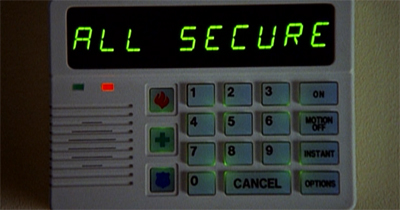
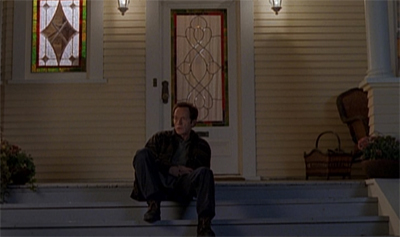
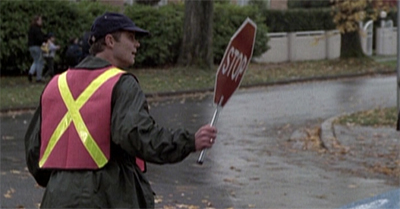

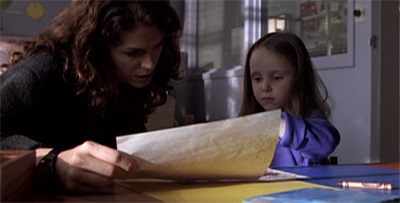


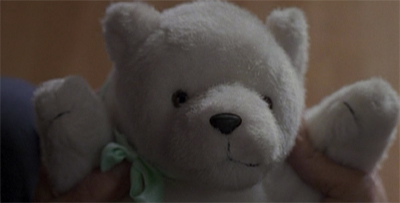

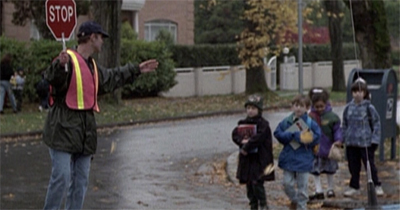

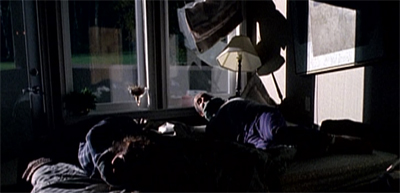
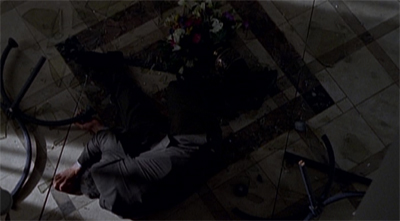
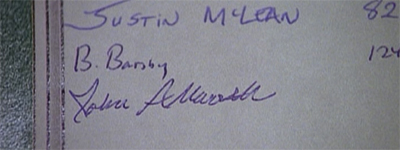
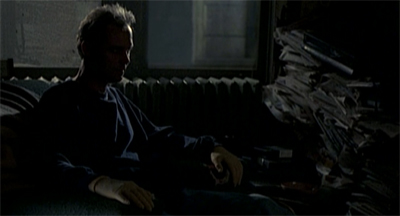





Leave a comment